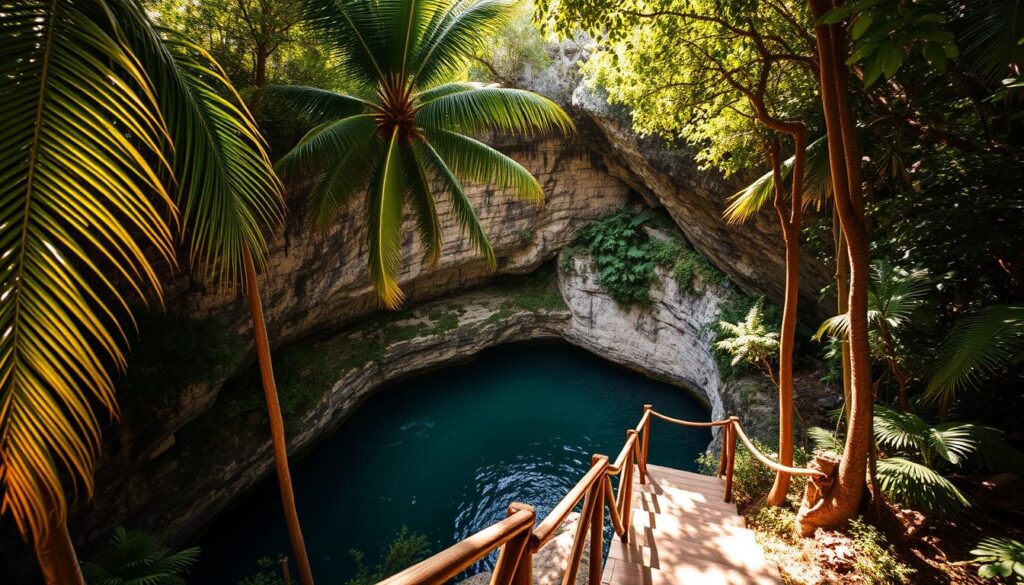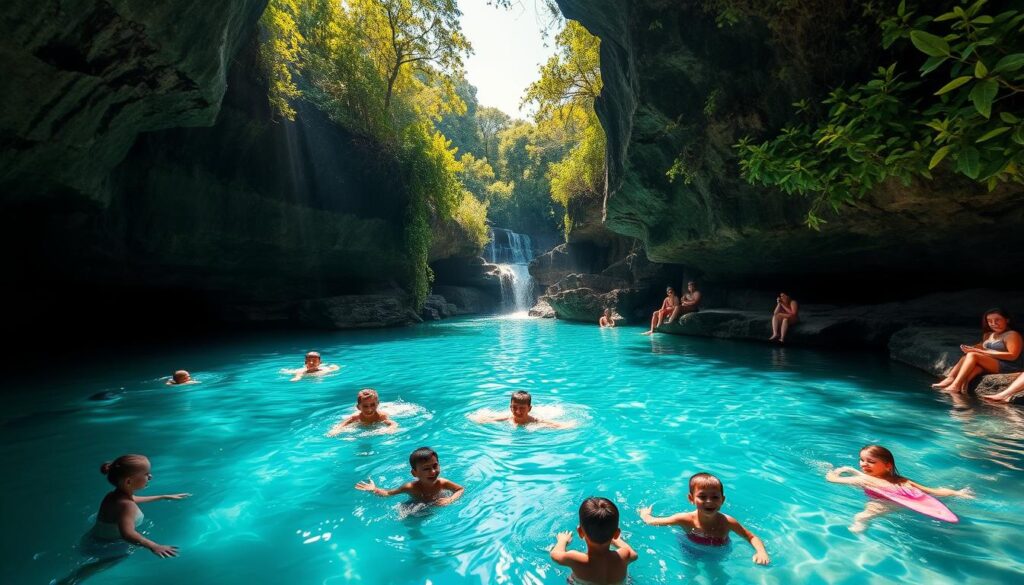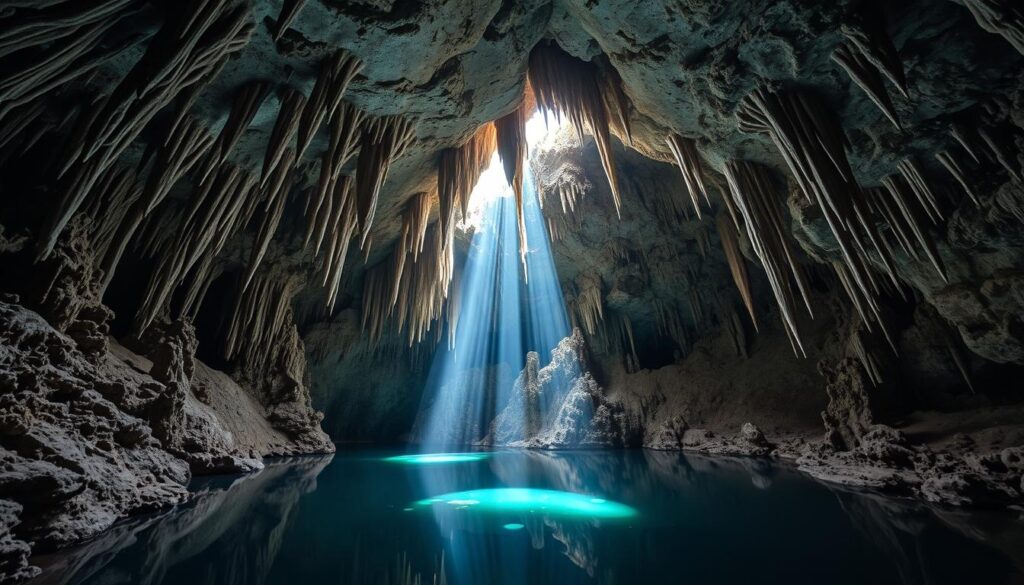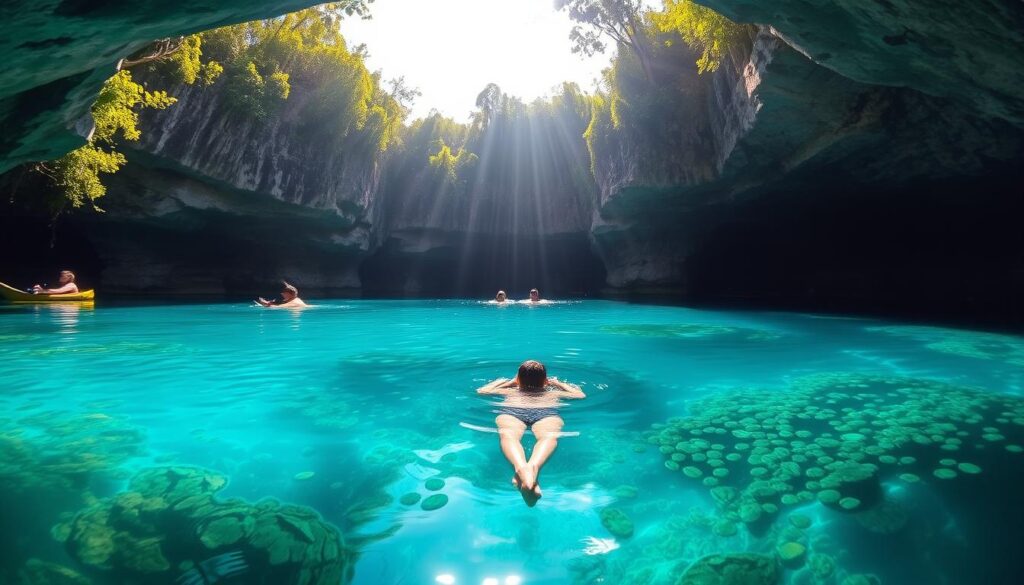Did you know that Tulum’s cenotes are home to some of the clearest water on Earth? These natural wonders attract thousands of visitors yearly, offering a glimpse into an underground world of beauty and mystery.
Located in the heart of the Yucatán Peninsula, Tulum is famous for its breathtaking cenote tulum formations. A cenote is a natural sinkhole filled with fresh water, often surrounded by lush jungle and ancient rock formations. These pool-like structures have been carved over millions of years, creating a unique ecosystem that captivates adventurers and nature lovers alike.
Whether you’re diving into crystal-clear depths or simply marveling at the serene surroundings, Tulum’s cenotes offer an unforgettable experience. In this article, we’ll guide you through the best cenotes to visit, share essential safety tips, and highlight the importance of preserving these natural treasures.
Key Takeaways
- Tulum’s cenotes feature some of the clearest water in the world.
- These natural pools are formed over millions of years.
- Cenotes are surrounded by lush jungle and ancient rock formations.
- They attract divers, swimmers, and nature enthusiasts.
- Preserving these ecosystems is crucial for future generations.
Introduction to Tulum’s Cenotes
Tulum’s cenotes are a breathtaking blend of natural beauty and geological wonder. These unique pools of clear water are nestled within dense jungle, creating a magical atmosphere that feels almost otherworldly. The combination of shimmering water and ancient rock formations makes these cenotes a must-see destination.
The Natural Allure of Crystal-Clear Pools
What makes these cenotes truly special is their clear water. Sunlight filters through the dense jungle, illuminating the pools and revealing their stunning depths. Surrounded by towering rock walls and lush greenery, these cenotes offer a serene escape from the outside world.
Whether you’re swimming, snorkeling, or simply soaking in the view, the beauty of these natural pools is undeniable. The interplay of light, water, and jungle creates a scene that feels like it’s straight out of a dream.
A Brief History and Formation of Cenotes
The formation of cenotes is a fascinating geological process. Over millions of years, limestone bedrock eroded, creating vast underground cave systems. When the roofs of these caves collapsed, they exposed the clear water below, forming the cenotes we see today.
These natural wonders were also deeply revered by the ancient Mayan civilization. They believed cenotes were sacred portals to the underworld and used them for rituals and ceremonies. Today, they remain a testament to both nature’s power and human history.
As you explore these cenotes, you’ll discover a world where rock, water, and jungle come together in perfect harmony. Their beauty and history make them a truly unforgettable experience.
Exploring the Cenotes of Tulum: Natural Swimming Holes
These natural pools are unlike anything you’ve ever seen. From open-air holes to intricate cave systems, each cenote offers a unique experience. Whether you’re diving into crystal-clear waters or exploring rocky passageways, the adventure is unforgettable.

What Makes These Pools Stand Out
One of the most striking features is the variety of cave structures. Some cenotes have vast underground chambers, while others are shallow and open. The entrance to each cenote is distinct, ranging from easy-access staircases to narrow rocky paths.
Swimming in these pools is a surreal experience. The water is cool and refreshing, and the natural contours of the caves create zones for exploration. From shallow areas perfect for families to deeper chambers for adventurers, there’s something for everyone.
These natural wonders have become a top pick for travelers. Their beauty, history, and unique formations make them a must-see. Whether you’re an experienced diver or a casual swimmer, the cenotes in Tulum promise an unforgettable journey.
Top Must-Visit Cenotes
Discover the most iconic cenotes in Tulum that promise unforgettable adventures. From breathtaking underwater caves to serene family-friendly spots, these natural wonders are a must-see for any traveler.
Dos Ojos – The Iconic “Two Eyes” Experience
Dos Ojos, meaning “Two Eyes,” is one of the most famous cenotes in the region. This stunning site features two interconnected pools, each offering a unique experience. The cenote dos ojos is renowned for its 1300-foot underwater corridor, making it a paradise for divers.
The crystal-clear waters and intricate cave systems create a mesmerizing environment. Whether you’re snorkeling or diving, the visibility is unparalleled. The natural light filtering through the openings adds to the magical atmosphere.
Located just a short drive from Tulum, Dos Ojos is open daily and offers facilities for visitors. Its accessibility and breathtaking beauty make it a top pick for adventurers and nature lovers alike.
Gran Cenote and Other Local Gems
Another must-visit is the Gran Cenote, known for its family-friendly environment and spectacular cave diving. This cenote is surrounded by lush greenery and features shallow areas perfect for beginners.
The underwater caves at Gran Cenote are a highlight for experienced divers. The clear waters and intricate rock formations create a surreal diving experience. It’s also a great spot for snorkeling, with plenty of marine life to admire.
Other local gems include Cenote Calavera and Cenote Carwash, each offering unique features. Whether you’re seeking adventure or relaxation, these cenotes provide a diverse range of experiences.
When planning your visit, check the opening hours and bring eco-friendly sunscreen to protect these pristine ecosystems. Each cenote offers something special, making Tulum a true paradise for nature enthusiasts.
Cenotes for Family Fun and Relaxation
Looking for a family-friendly adventure in Tulum? The cenotes here offer safe, scenic spots perfect for a relaxing day out. These natural pools are ideal for visitors of all ages, providing a mix of fun and tranquility.

Safe, Accessible, and Scenic Spots
Many cenotes in the area are known for their calm, shallow waters, making them perfect for family outings. These spots are designed with safety in mind, ensuring a worry-free experience for parents and kids alike.
One of the highlights is the opportunity for easy snorkeling. The clear, shallow waters allow even beginners to explore the underwater world comfortably. Designated picnic areas also make it easy to enjoy a meal surrounded by nature.
Examples like Cenote Azul and Cenote Cristalino are popular choices. Both offer clear safety guidelines and accessible facilities, making them a top pick for families. These cenotes provide a peaceful retreat from the busier tourist areas, ensuring a fun and relaxing day.
Whether you’re splashing in the water or lounging by the shore, these cenotes are the perfect spot for creating lasting memories with your loved ones.
Snorkeling and Diving Opportunities
For water sports enthusiasts, Tulum’s cenotes offer unparalleled snorkeling and diving experiences. These natural pools are a gateway to an underwater world filled with stunning rock formations and crystal-clear waters. Whether you’re a seasoned diver or a beginner, there’s something for everyone.
Exploring Underwater Cave Systems
Many cenotes, like Dos Ojos and Gran Cenote, connect to extensive underwater cave systems. These submerged passages are a magnet for divers from around the world. The thrill of navigating through these caves is unmatched, offering a mix of challenge and excitement.
The clear waters provide excellent visibility, making it easy to admire the intricate rock formations. However, exploring these caves requires skill and caution. Always dive with a guide and ensure you have the proper training.
Essential Gear and Safety Guidelines
When preparing for a diving adventure, having the right gear is crucial. A life jacket is essential for safety, especially for beginners. It helps conserve energy and provides buoyancy in the water.
Other must-have items include a reliable scuba mask, fins, and a waterproof flashlight for exploring darker areas. Always check your equipment before diving to ensure everything is in working order.
Respecting the delicate ecosystem is also important. Avoid touching the rock formations or disturbing marine life. Follow local guidelines to help preserve these natural wonders for future generations.
With the right preparation and mindset, diving in Tulum’s cenotes can be an unforgettable adventure. Whether you’re snorkeling in shallow waters or exploring deep caves, the experience is truly one-of-a-kind.
The Geology and Formation of Cenotes
Cenotes are the result of millions of years of natural transformation. These stunning formations are shaped by the slow but powerful forces of geology. Understanding their creation offers a deeper appreciation for their beauty and significance.

Limestone Erosion and Subterranean Rivers
The Yucatán Peninsula is primarily composed of limestone, a porous rock that plays a key role in cenote formation. Over time, rainwater, slightly acidic from absorbing carbon dioxide, seeps into the ground. This process gradually dissolves the limestone, creating vast underground cave systems.
As these caves expand, they often connect to subterranean rivers, which further erode the rock. The combination of water flow and limestone dissolution shapes the intricate networks we see today. When the ceilings of these caves collapse, they expose the water below, forming the iconic cenotes.
Natural Cave Systems and Stalactites
Inside these cave systems, you’ll find stunning geological features like stalactites. These formations hang from the ceilings and are created by mineral-rich water dripping over thousands of years. The slow accumulation of minerals builds these delicate yet durable structures.
The depth of cenotes varies widely, from shallow pools to deep caverns. Some extend hundreds of feet below the surface, offering a glimpse into the Earth’s hidden layers. This diversity in depth and structure makes each cenote unique.
These geological processes have shaped the Yucatán Peninsula into a landscape of wonder. From the subterranean rivers to the towering stalactites, every detail tells a story of nature’s artistry. Exploring these formations is like stepping into a living museum of Earth’s history.
Preserving and Respecting Pristine Ecosystems
Sustainable travel practices are key to protecting the pristine beauty of these natural pools. The cenotes in the area are delicate ecosystems that require careful attention to maintain their allure. Environmental experts stress the importance of responsible tourism to ensure these treasures remain unspoiled for future generations.
One of the simplest ways to help is by rinsing off before entering the water. This removes harmful chemicals from your skin, such as sunscreen and insect repellent. These products can damage the fragile balance of the cenote’s ecosystem. Opt for eco-friendly alternatives to minimize your impact.

Tour operators in the location are also taking steps to promote sustainability. Many have adopted eco-friendly measures, such as limiting group sizes and providing biodegradable products. These efforts help reduce the environmental footprint of visitors while preserving the natural beauty of the jardin del eden.
Here are some best practices for visitors:
| Practice | Benefit |
|---|---|
| Avoid chemical sunscreens | Protects water quality |
| Use biodegradable products | Reduces environmental impact |
| Follow designated paths | Prevents erosion and damage |
| Respect wildlife | Maintains natural balance |
The del eden cenotes are more than just tourist attractions; they are vital parts of the local ecosystem. By adopting these practices, visitors can help preserve these natural wonders. Every small action contributes to the larger goal of keeping these pristine locations unspoiled.
Remember, the responsibility lies with each visitor. By being mindful of your impact, you can ensure that the jardin del eden remains a breathtaking destination for years to come. Let’s work together to protect these invaluable natural treasures.
Local Culture and Myths Surrounding Cenotes
The cenotes near Tulum are steeped in cultural and mythological significance, offering more than just natural beauty. These water formations have been central to Mayan traditions for centuries, serving as sacred sites and gateways to the spiritual world.
For the Mayan people, cenotes were more than just sources of water. They were revered as portals to the underworld, known as Xibalba. Rituals and offerings were often conducted at these sites to honor deities and ancestors. This deep connection to the cenotes adds layers of meaning to their already stunning presence.
Mayan Legends and Traditional Beliefs
One of the most famous cenotes, Casa Cenote, is deeply tied to Mayan mythology. According to local legends, it was a place where the gods communicated with the living. The Mayans believed that the cenote’s waters held healing properties and spiritual energy.
In Playa del Carmen, cenotes were also used for ceremonial purposes. Artifacts and remains found in these areas provide evidence of their historical significance. Today, these sites continue to attract visitors who are drawn to their mystical allure.
Modern tourism has brought new life to these ancient sites. While visitors flock to Playa del Carmen and Del Carmen for their beauty, many also seek to connect with the cultural heritage. Local guides often share stories and legends, enriching the experience for travelers.
| Cultural Practice | Significance |
|---|---|
| Ritual Offerings | Honored deities and ancestors |
| Healing Ceremonies | Believed to harness spiritual energy |
| Storytelling | Preserved Mayan legends |
| Artifact Preservation | Provided historical insights |
These cultural stories add depth to the natural beauty of the cenotes. Whether you’re visiting Casa Cenote or exploring the cenotes near Playa del Carmen, understanding their cultural significance enhances the experience. It’s a reminder that these sites are not just geological wonders but also cultural treasures.
Planning Your Trip to Tulum Cenotes
Planning a trip to Tulum’s cenotes requires careful preparation to make the most of your adventure. These natural wonders are scattered across the region, and knowing the best times to visit, transportation options, and what to expect will ensure a seamless experience.
Best Times to Visit and What to Expect
To avoid crowds and enjoy a tranquil experience, arrive early in the morning, typically around opening times. The cooler temperatures and softer light during this period also enhance the beauty of the cenotes. Midday can get busy, so plan accordingly if you prefer a quieter visit.
Most cenotes open between 8 AM and 5 PM, but hours may vary. Check ahead to confirm opening times for specific locations. Some cenotes are part of larger cave system world networks, offering unique exploration opportunities. Be prepared for varying water temperatures, as some cenotes are cooler due to their underground nature.
Transportation and Accessibility Tips
Having a car is the most convenient way to explore Tulum’s cenotes, especially for reaching remote sites. The local road network is well-maintained, but GPS navigation is recommended for ease of travel. Parking is usually available near popular cenotes, often within a minute walk from the entrance.
If you prefer not to drive, taxis and colectivos (shared vans) are affordable alternatives. Colectivos follow fixed routes and can drop you off near major cenotes. However, they may require a short walk or additional transportation to reach the exact location.
For a hassle-free experience, consider booking a guided tour. Many operators provide transportation, equipment, and local insights, making it easier to navigate the cave system world and other attractions.
Here are some practical tips for your trip:
- Wear comfortable, water-friendly footwear for walking on rocky paths.
- Bring biodegradable sunscreen and insect repellent to protect the environment.
- Carry cash for entrance fees, as some cenotes may not accept cards.
- Pack a reusable water bottle to stay hydrated during your visit.
With proper planning, your trip to Tulum’s cenotes will be a memorable adventure. Whether you’re driving along the scenic roads or exploring the depths of a cave system world, every moment will be worth it.
Tips for a Sustainable Cenote Visit
Protecting the natural beauty of cenotes is a shared responsibility for every visitor. These stunning pools are delicate ecosystems that require mindful practices to remain pristine. By adopting eco-friendly habits, you can enjoy your visit while contributing to conservation efforts.
Do’s and Don’ts for Eco-Friendly Travel
Being a responsible swimmer starts with simple actions. Avoid using chemical sunscreens or insect repellents, as they can harm the water quality. Instead, opt for biodegradable products that are safe for the environment.
Respect the natural surroundings by staying on designated paths. This prevents erosion and protects the fragile vegetation. Always dispose of trash properly or carry it out with you to keep the area clean.
Here’s a quick guide to eco-friendly practices:
- Do rinse off before entering the water to remove harmful chemicals.
- Don’t touch or disturb the rock formations or marine life.
- Do use reusable water bottles and containers to reduce waste.
- Don’t bring single-use plastics into the cenote area.
How to Keep the Water Pristine
Maintaining the clarity and health of the water is crucial for the life within these ecosystems. Avoid introducing pollutants by using eco-friendly sunscreen and avoiding lotions before swimming. This helps preserve the natural balance of the cenote.
Support local initiatives that promote sustainability. Many cenotes, like jardin del and cenote dos, have adopted measures to protect their environments. By following their guidelines, you contribute to these efforts.
Remember, every small action counts. By being mindful of your impact, you ensure these natural wonders remain breathtaking for future generations. Let’s work together to protect these invaluable treasures.
Insider Tips for a Memorable Adventure
Uncover the secrets of Tulum’s hidden cenotes for an unforgettable adventure. While popular spots draw crowds, lesser-known gems offer a tranquil and unique experience. With a little planning, you can escape the hustle and discover the magic of these secluded natural wonders.
Hidden Gems and Avoiding the Crowds
One of the best ways to enjoy Tulum’s cenotes is by exploring off-the-beaten-path locations. Cenote Azul, for example, is a stunning spot that’s often overlooked by mainstream tourists. Its crystal-clear waters and serene surroundings make it a perfect escape.
To avoid crowds, visit early in the morning or later in the afternoon. These times offer cooler temperatures and softer light, enhancing the beauty of the cenotes. Weekdays are also less busy compared to weekends.
For a truly unique experience, consider venturing a few miles outside Tulum. Many secluded cenotes are nestled in the jungle, offering a peaceful retreat. These hidden spots often connect to intricate underwater cave systems, perfect for adventurous explorers.
Here are some insider tips for your visit:
- Research lesser-known cenotes like Cenote Azul for a quieter experience.
- Arrive early or late to avoid peak hours and enjoy the serenity.
- Bring biodegradable sunscreen and eco-friendly gear to protect the environment.
- Consider renting a car to access remote cenotes, as some are a short drive away.
By following these tips, you’ll discover the hidden beauty of Tulum’s cenotes. Whether you’re exploring a secluded underwater cave system or relaxing at Cenote Azul, your adventure will be truly unforgettable.
Conclusion
Tulum’s cenotes stand as a testament to nature’s artistry and cultural richness. These stunning underwater caves offer a unique blend of adventure and tranquility, making them a must-visit place for travelers. From crystal-clear waters to intricate rock formations, every cenote tells a story of geological wonder and Mayan heritage.
As you plan your journey, remember to explore with respect. Sustainable practices, like using eco-friendly sunscreen and staying on designated paths, help preserve these natural treasures. By doing so, you contribute to protecting one of the most fascinating wonders of the world.
Whether you’re diving into hidden underwater caves or simply soaking in the serene beauty, Tulum’s cenotes promise an unforgettable experience. Pack your gear, embrace the adventure, and discover the magic of this extraordinary destination.



